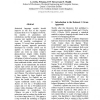98
Voted
ACL
2006
15 years 2 months ago
2006
Parsing is a computationally intensive task due to the combinatorial explosion seen in chart parsing algorithms that explore possible parse trees. In this paper, we propose a meth...
104
Voted
ACL
2006
15 years 2 months ago
2006
This article describes a robust semantic parser that uses a broad knowledge base created by interconnecting three major resources: FrameNet, VerbNet and PropBank. The FrameNet cor...
93
Voted
ACL
2006
15 years 2 months ago
2006
Various methods have been proposed for automatic synonym acquisition, as synonyms are one of the most fundamental lexical knowledge. Whereas many methods are based on contextual c...
ACL
2006
15 years 2 months ago
2006
We investigate prototype-driven learning for primarily unsupervised grammar induction. Prior knowledge is specified declaratively, by providing a few canonical examples of each ta...
96
Voted
ACL
2006
15 years 2 months ago
2006
Synchronous Context-Free Grammars (SCFGs) have been successfully exploited as translation models in machine translation applications. When parsing with an SCFG, computational comp...
127
Voted
ACL
2006
15 years 2 months ago
2006
We present MAGEAD, a morphological analyzer and generator for the Arabic language family. Our work is novel in that it explicitly addresses the need for processing the morphology ...
64
Voted
ACL
2006
15 years 2 months ago
2006
Statistical language models should improve as the size of the n-grams increases from 3 to 5 or higher. However, the number of parameters and calculations, and the storage requirem...
ACL
2006
15 years 2 months ago
2006
Hidden Markov models (HMMs) are powerful statistical models that have found successful applications in Information Extraction (IE). In current approaches to applying HMMs to IE, a...
85
Voted
ACL
2006
15 years 2 months ago
2006
One of the challenges in the automatic generation of referring expressions is to identify a set of domain entities coherently, that is, from the same conceptual perspective. We de...
ACL
2006
15 years 2 months ago
2006
We claim that existing specification languages for tree based grammars fail to adequately support identifier managment. We then show that XMG (eXtensible MetaGrammar) provides a s...



